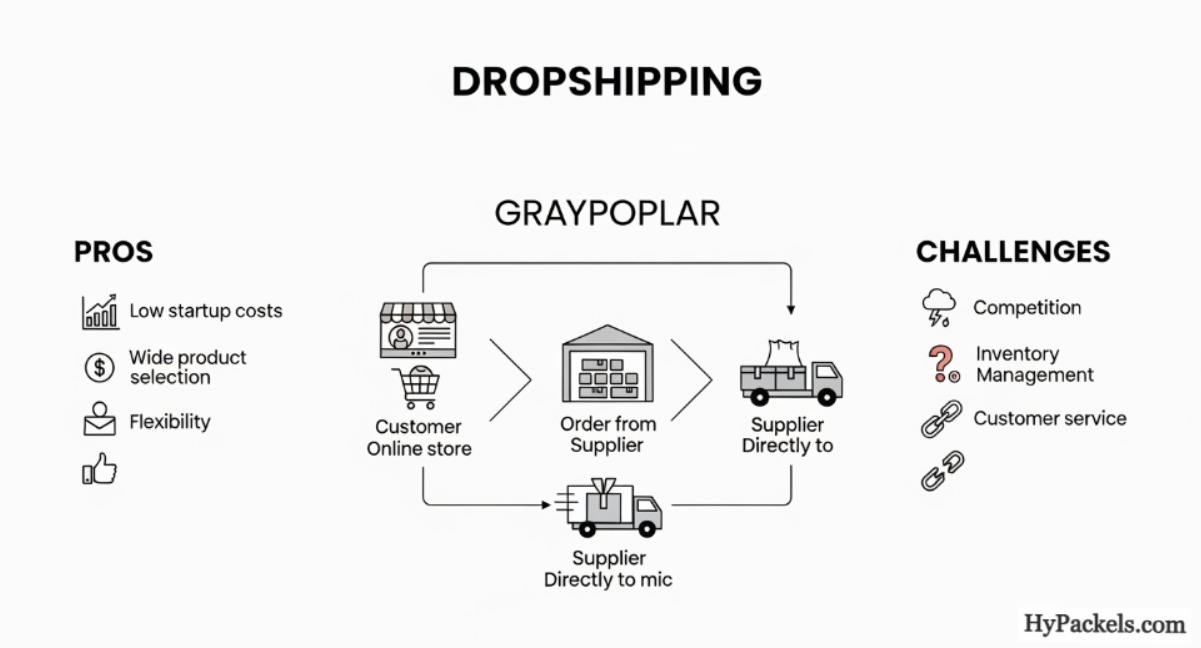Introduction
E-commerce continues to evolve, offering countless opportunities for entrepreneurs worldwide. One of the most disruptive business models to emerge in recent years is dropshipping, which allows sellers to operate without holding inventory. Within this fast-growing space, the concept of dropshipping graypoplar has started gaining attention.
But what exactly does it mean, how does it work, and is it really a sustainable business option?
This comprehensive guide explores everything about dropshipping graypoplar—from fundamentals and strategies to challenges, opportunities, and real-world examples.
What Is Dropshipping Graypoplar?
Dropshipping graypoplar combines two elements:
- Dropshipping: A retail fulfillment method where the seller markets and sells products but relies on third-party suppliers for storage, packaging, and shipping.
- Graypoplar: Often linked with eco-conscious, versatile, or niche products, particularly those associated with sustainable or natural markets.
When combined, dropshipping graypoplar refers to selling graypoplar-related products (or those under a Graypoplar brand niche) through the dropshipping model.
This can include:
- Home and lifestyle products made from gray poplar wood.
- Eco-friendly, plant-based, or natural materials under the “Graypoplar” label.
- Niche e-commerce categories are branded around sustainability, minimalism, or modern living.
Why Dropshipping Graypoplar Is Different from Traditional Dropshipping
While traditional dropshipping often focuses on trending but short-lived products, dropshipping graypoplar emphasizes:
- Sustainability – Eco-friendly products align with conscious consumerism.
- Longevity – Rather than fast-fashion fads, these products appeal to long-term lifestyle choices.
- Trustworthiness – Consumers increasingly value transparency, and brands associated with sustainable sourcing (like graypoplar) can build stronger trust.
- Brand Differentiation – Sellers can avoid overly saturated markets by targeting niche audiences.
How Dropshipping Graypoplar Works
- Choose Your Niche
- Decide which category of graypoplar-related products to sell: home décor, furniture, wellness products, or eco-living items.
- Find Reliable Suppliers
- Partner with suppliers who specialize in graypoplar products or sustainable goods.
- Set Up Your Online Store
- Platforms like Shopify, WooCommerce, or BigCommerce work well for dropshipping models.
- Add Products to Your Catalog
- Import supplier products into your store with proper descriptions, pricing, and images.
- Market Your Brand
- Use SEO, content marketing, and social media targeting eco-conscious buyers.
- Process Orders Automatically
- When a customer purchases, the order is forwarded to the supplier.
- Supplier Ships the Product
- The supplier handles packaging, labeling, and delivery directly to the customer.
- Build Customer Loyalty
- Focus on customer experience, brand storytelling, and after-sales support.
Benefits of Dropshipping Graypoplar
- Low Startup Costs – No need to invest in warehouses or bulk inventory.
- Scalable Model – Expand quickly without worrying about stock management.
- Eco-Friendly Branding – Align with rising demand for sustainable products.
- Reduced Risk – Only pay suppliers after sales are made.
- Flexibility – Operate from anywhere with an internet connection.
Challenges of Dropshipping Graypoplar
- Supplier Reliability – Delayed shipping or inconsistent quality can harm your reputation.
- Thin Profit Margins – Competitive markets can lower earnings unless you differentiate.
- Brand Building – Harder to stand out without unique value propositions.
- Customer Expectations – Eco-conscious buyers expect authenticity and transparency.
- Limited Control – Sellers depend heavily on supplier performance.
Dropshipping Graypoplar Market Trends
Recent studies suggest:
- Eco-commerce Growth: Sustainable product markets are growing at double-digit rates annually.
- Consumer Mindset Shift: More than 60% of online shoppers prefer eco-friendly products when given a choice.
- Global Reach: Dropshipping enables entrepreneurs to access global markets without high upfront investments.
These trends indicate that dropshipping graypoplar has long-term potential for entrepreneurs who align with ethical, modern consumer preferences.
Strategies to Succeed with Dropshipping Graypoplar
1. Focus on Niche Branding
- Position your store as a sustainable lifestyle hub rather than a generic e-commerce store.
2. Optimize Product Descriptions
- Highlight benefits such as eco-friendliness, durability, and aesthetic appeal.
3. Leverage Content Marketing
- Publish blogs, guides, and tutorials about graypoplar products, eco-living, and minimalism.
4. Use SEO & Semantic Optimization
- Include keywords like eco-friendly products, sustainable dropshipping, natural lifestyle goods, etc.
5. Offer Excellent Customer Support
- Provide real-time assistance, hassle-free returns, and transparent shipping policies.
6. Diversify Suppliers
- Avoid dependency on a single supplier to reduce operational risks.
Comparing Dropshipping Graypoplar vs. Traditional Dropshipping
| Factor |
Traditional Dropshipping |
Dropshipping Graypoplar |
| Focus |
Trend-driven products |
Sustainable/niche products |
| Market Competition |
Highly saturated |
Less saturated, niche-based |
| Customer Loyalty |
Low |
Higher due to values alignment |
| Long-Term Potential |
Uncertain |
Strong, aligned with eco trends |
| Branding Opportunities |
Limited |
Strong sustainability story |
Actionable Tips for Entrepreneurs
- Test Products First – Order samples to ensure quality before selling.
- Build a Story – Create a compelling brand narrative around sustainability.
- Target Communities – Join eco-living forums, groups, and niche markets.
- Invest in Packaging – Even if suppliers ship directly, request eco-friendly packaging.
- Track Analytics – Use tools to monitor customer behavior and refine strategies.
Conclusion
Dropshipping graypoplar offers a unique opportunity to blend sustainability with entrepreneurship. Unlike saturated dropshipping niches, it positions sellers within a growing market of eco-conscious consumers. While challenges such as supplier dependency and competition exist, the benefits—low startup costs, scalability, and long-term demand—make it a compelling option.
By combining strategic branding, reliable suppliers, and customer-focused experiences, dropshipping graypoplar can evolve into a sustainable and profitable business model. For aspiring entrepreneurs seeking to align profits with purpose, this path is worth exploring.
